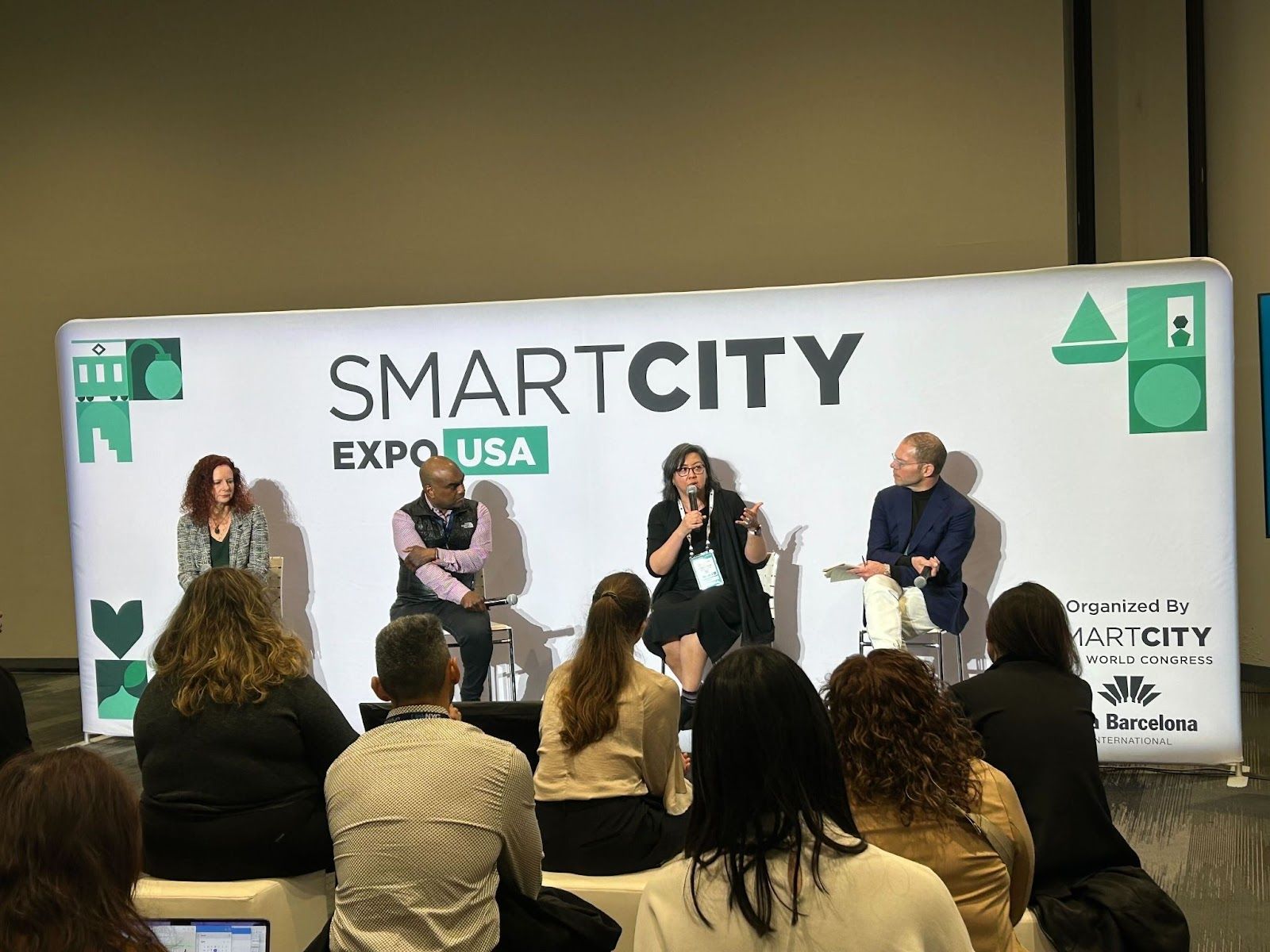
DTPR was developed with a simple but crucial mission: help people understand the digital technologies operating in their public spaces. This April marked the 5 year anniversary of when Digital Trust for Places and Routines (DTPR) leapt off the drawing board and first piloted in the real world.
At Smart City Expo USA in New York City, with the help of futurist Greg Lindsay, we had the chance to reflect on how far we've come—and discuss the new challenges presented by the acceleration of AI in cities. Our CEO and founder, Jacqueline Lu was joined by two amazing civic tech innovators - Lea Eriksen (City of Long Beach, CA) and Nigel Jacob (City of Boston, MA). Together we reflected on the five years since DTPR was first piloted in the real world with the City of Boston, and how it continues to grow and anchor technology innovation initiatives such as the City of Long Beach’s Smart City Program.
It's incredible to see how this idea, that everyone should be able to understand the invisible layers of the city, has gotten traction around the world! Here’s a little snapshot of what we talked about - and an invitation to help develop what’s next.
Our discussion started with a hard truth: Google's failed Sidewalk Toronto project was our collective wake-up call. This ambitious smart city project sought to provide a blueprint for how technology could help improve quality of life in cities, but the proposal was met with substantial public concerns and questions about how it would all work.
People intuitively understood they were dealing with a new form of infrastructure, that digital and AI were becoming part of cities in ways that shape community outcomes just like roads and parks do. But unlike physical infrastructure, at the time there was no way for residents to easily understand what was being proposed, and therefore, have a meaningful dialogue about it.
That's where DTPR was born—from the recognition that when people can't understand the technology around them, fear fills that information vacuum. The lesson? Transparency isn't optional; it's essential.
Nigel Jacob, visiting fellow at MIT's Leventhal Center and co-founder of Boston's Mayor's Office of New Urban Mechanics, was among the first to recognize DTPR's potential. In 2020, Boston faced mounting questions from residents about cameras and sensors on city infrastructure.
"We were getting lots of questions through our 311 system about what that thing on the light pole was doing," Jacob recalled. "There was a lot of assumption that it was surveillance, and we needed a way to engage the public in dialogue about it in a step-wise way."
Boston's implementation of DTPR created curiosity rather than fear. While residents initially needed some explanation about the new visual language, DTPR sparked exactly the kind of dialogue the city hoped for—productive conversations about technology use rather than polarized debates.
The City of Long Beach took DTPR implementation to the next level, integrating it into a comprehensive digital rights platform. Lea Eriksen, the city's CIO and Director of Technology and Innovation, shared how Long Beach made transparency a cornerstone of their smart city strategy.
When the city surveyed residents about smart city technology, they discovered that 40% had never heard the term "smart city" before, yet 80% expressed concerns about privacy and data use. These findings directly informed their approach, with "earn public trust" becoming one of four guiding principles in their smart city strategy.
"We have over 25 technologies demonstrated on our digital rights platform and counting," Eriksen noted. The platform has already driven concrete changes—when residents expressed concern about indefinite data retention periods for certain technologies, the city modified its policies to retain data only as long as necessary.
The panel addressed perhaps the most pressing question: how does DTPR evolve for the age of AI? Today's municipal leaders are already grappling with AI-powered traffic management, automated permit processing, and predictive policing tools. But here's the challenge: How do you explain algorithmic decision-making to residents who are already suspicious of cameras on light poles?
"We're seeing increasing public pressure and legislative demand for transparency around algorithms," Lu noted. "The question we have for the standard is how can we make the underlying compliance and risk assessment documentation also useful to the public."
This 5-year milestone comes at a critical moment—after learning from municipal pioneers like Boston and Long Beach on how DTPR enables smart city transparency, we're now working on extending these learnings and tools to help cities explain the AI systems that are rapidly becoming part of municipal operations.
As the panelists emphasized, this isn't a future problem—it's happening now. Cities are deploying AI systems that make decisions affecting residents' daily lives, from determining which potholes get fixed first to flagging permit applications for review.
As Helpful Places enters and navigates the 5th year of bringing DTPR into the real world, one thing is clear: technology serves people best when people understand it, and as AI becomes more prevalent in the way our communities work, enabling that understanding becomes even more critical.
This blog post is based on insights from our panel discussion moderated by Greg Lindsay, featuring Jacquline Lu (CEO, Helpful Places), Nigel Jacob (MIT Leventhal Center), and Lea Eriksen (CIO, City of Long Beach). To watch the full discussion click here.
As AI becomes embedded in our public spaces and municipal services, communities need transparency tools that can keep pace. DTPR has now been used around the world to bring transparency to data collection in public space, proving effective at communicating the who, how, where, and why of technology deployment while breaking down internal silos between departments. That's why we're developing DTPR for AI—extending these proven approaches to tackle the next wave of algorithmic transparency challenges. Join our evolving DTPR for AI discussion and help shape how cities will communicate algorithmic systems to their communities.